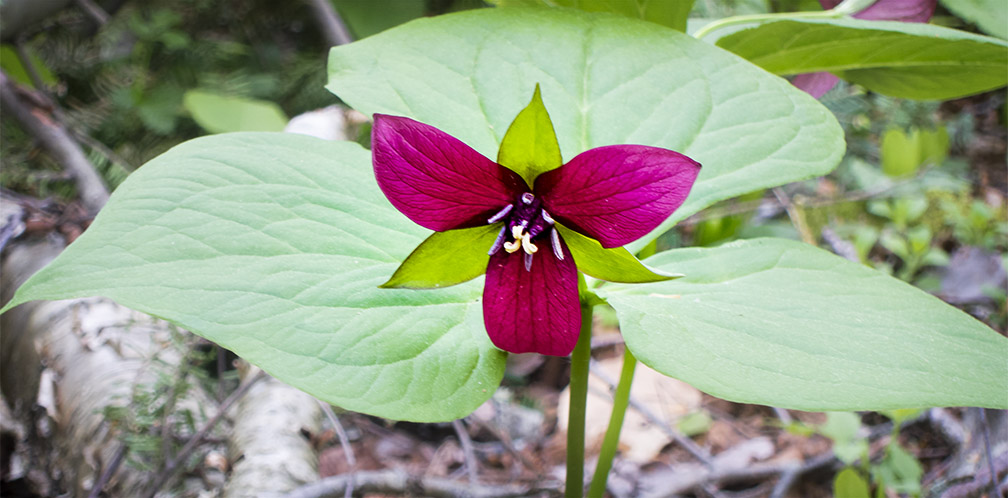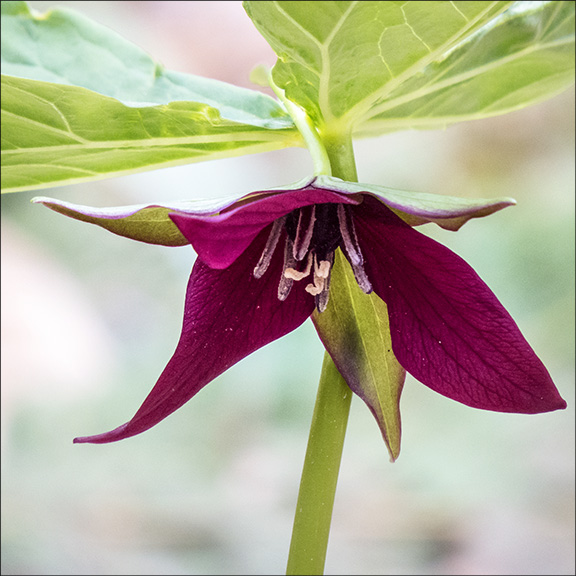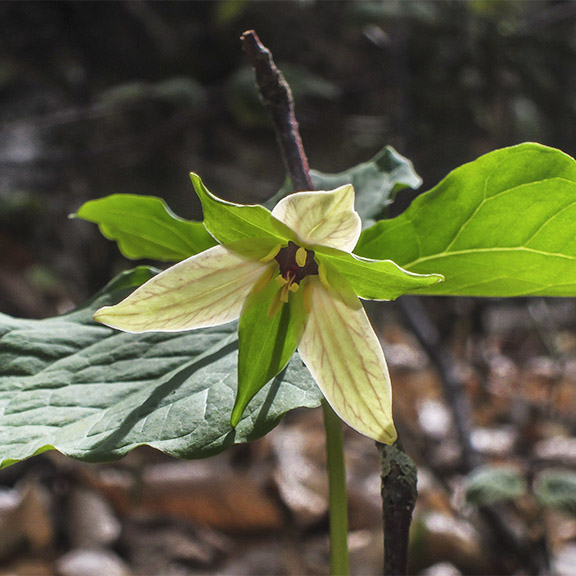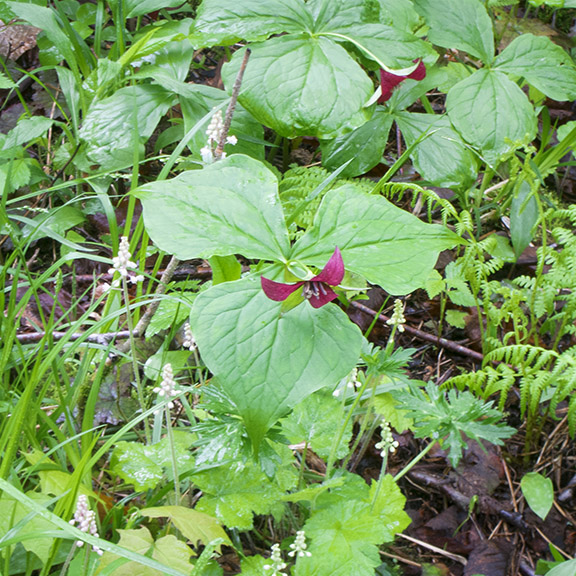Wildflowers of the Adirondacks:
Purple Trillium (Trillium erectum)

Purple Trillium (Trillium erectum) is a perennial wildflower with deep red, three-petaled flowers growing above three large green whorled leaves. It blooms in spring in the Adirondack Mountains of upstate New York. It is a member of the lily family. Its genus name (Trillium) is derived from the Latin word for "three," a reference to the fact that the floral parts of the plant occur in threes (three leaves, three petals, three sepals). The species name (erectum) is a reference to the plant's erect habit.
Purple Trillium is known by a wide variety of common names:
- Purple Trillium is also known as Stinking Benjamin, Illscented Trillium, Illscented Wakerobin, Stinking Willie, Wet Dog Trillium, and Wet Dog Wakerobin. These names are a reference to the fact that the flowers have an unpleasant, fetid scent which attracts flesh flies, carrion beetles, and similar insects to act as pollinators.
- The plant has also been referred to by names which evoke its purported medicinal uses as an aid to childbirth, including Bethroot, Bettroot, Birthroot, Birthwort, Indian Balm, Squaw Flower, and Squaw Root.
- Other common names include Red Trillium, Red Benjamin, Purple Wakerobin, Red Wakerobin, Wakerobin, and Wake-robin. These latter names apparently relate to the red color of the petals (a reference to the red breast of the American Robin), as well as the plant's spring blooming schedule, which coincides roughly with the return of robins to northeastern areas.
Identification of Purple Trillium

Purple Trilliums are perennial wildflowers that grow from 6 to 20 inches high, with a single central stem and three widely spreading leaves. The stems are light to purplish green and smooth (hairless).
The Purple Trillium has three whorled leaves per node. The unstalked leaves arise from the base of the flower stalk. The leaves are two to six inches long, hairless and roughly diamond in shape. The edges are smooth (no teeth). The leaves have a network of veins; the primary veins are parallel while the secondary veins form an interlacing network.
The flowers of the Purple Trillium are about two to three inches wide, with purple or maroon petals, three light green to greenish maroon sepals, and six stamens. The flowers grow on a short erect or curved stalk, standing about 1-4 inches above the leaves of the plant. The petals are lance-shaped and free from hair. The sepals are a bit smaller and narrower. The stamens have anthers with light gray to yellowish pollen. Although the usual flower color is dark reddish-purple, occasionally light yellow, greenish, pink, or white flowers may be seen.

In the Adirondacks, Purple Trilliums usually begin blooming in early May. Purple Trilliums in bloom can generally be seen in the Trilakes area to about the end of May or very early June. A tally of flowering dates for the upland Adirondack areas compiled by Michael Kudish, based on data collected from the early seventies to the early nineties, lists the earliest bud date as 19 April, the median bud date as 26 April, and the latest bud date as 5 May. He lists the earliest full flower date as 30 April, the median full flower date as 12 May, and the latest full flower date as 7 June.
The petals wither in about 2-3 weeks, leaving a fleshy, berry-like fruit with three lobules. The capsule changes from green to red or purple and eventually drops from the plant.
Uses of Purple Trillium
Native American groups used the root of Purple Trillium as an aid to childbirth . (An alternate name for the plant, "Bethroot," is a corruption of the term "birth root.") The whole plant was made into a poultice used to treat tumors, inflammation, and ulcers. Purple Trillium was also used as a remedy for coughs and ulcers.
Edible uses of the plant are limited. Some sources recommend using the leaves (gathered before the appearance of the flowers) as an addition to salads or as a cooked vegetable. The berries and roots are inedible and are said to be poisonous.
Wildlife Value of Purple Trillium

The wildlife value of Purple Trillium is limited. The larvae of several moth species have been observed feeding on the leaves. Birds and mammals (such as the White-tailed Deer) are said to browse on the leaves or eat the berries, but the plant does not form a substantial part of their diets.
Distribution of Purple Trillium
The Purple Trillium is native to the east and northeastern areas of North America. The plant is found from Manitoba, Canada, east to Nova Scotia, south to Georgia and Alabama, and north to Illinois and Michigan. Purple Trillium is listed as Endangered in Illinois, Threatened in Rhode Island, and Exploitably Vulnerable in New York State.
In New York State, Purple Trillium can be found in almost all counties. It occurs in all counties within the Adirondack Park Blue Line.
Habitat of Purple Trillium
Purple Trilliums grow in rich woodland, in damp shady woods. It is shade-tolerant. This species is common in the Adirondacks, where it grows to an altitude of about 3500 feet. It is often found under deciduous trees in northern hardwood forests, but it is also commonly seen in mixed wood forests. Purple Trilliums are found in several ecological communities in the Adirondack Mountains, including maple-basswood rich mesic forest, hemlock-northern hardwood forest, and beech-maple mesic gorest.
You can find this plant along sections of virtually all trails covered here. In mixed wood habitats, look for Purple Trilliums growing under Sugar Maple, Red Maple, Yellow Birch, and Eastern Hemlock. Striped Maple is often prominent as a mid-story tree, with Hobblebush at lower levels. Other wildflowers growing near Purple Trilliums include Canada Mayflower, Indian Cucumber Root, Foamflower, and Rose Twisted Stalk. Birds found in this habitat include Blue-headed Vireo, Black-throated Green Warbler, and Blackburnian Warbler.
References
Michael Kudish. Adirondack Upland Flora: An Ecological Perspective (The Chauncy Press, 1992), pp. 25, 232, 249.
New York Flora Association. New York Flora Atlas. Purple Trillium. Trillium erectum L. Retrieved 3 November 2017.
United States Department of Agriculture. NRCS National Plant Data Center & the Biota of North America Program. Plant Guide. Red Trillium. Trillium erectum L.
Retrieved 3 November 2017.
United States Department of Agriculture. Forest Service. Plant of the Week. Red trillium (Trillium erectum L.) Retrieved 3 November 2017.
United States Department of Agriculture. US Forest Service. A Guide to Medicinal Plants of Appalachia (RESEARCH PAPER NE-138, 1969), p. 156. Retrieved 3 November 2017.
Flora of North America. Trillium erectum Linnaeus. Retrieved 3 November 2017.
NatureServe Explorer. Online Encyclopedia of Life. Trillium erectum - L. Retrieved 3 November 2017.
New England Wildflower Society. Go Botany. Red Trillium. Trillium erectum L. Retrieved 3 November 2017.
New York State. Department of Environmental Conservation. New York Natural Heritage Program. Ecological Communities of New York State. Second Edition (March 2014), pp. 119-120, 120-121, 121. Retrieved 17 October 2015.
New York State. Adirondack Park Agency. Preliminary List of Species Native Within the Adirondack Park Listed Alphabetically by Scientific Name and Sorted by Habit. Volume 1. Updated 10.23.2006, p. 40. Retrieved 26 January 2017.
USA National Phenology Network. Nature’s Notebook. Trillium erectum. Retrieved 3 November 2017.
Connecticut Botanical Society. Wake-robin. Trillium erectum L. Retrieved 3 November 2017.
University of Wisconsin. Flora of Wisconsin. Trillium erectum L. Retrieved 3 November 2017.
Illinois Wildflowers. Red Trillium. Trillium erectum. Retrieved 3 November 2017.
Lady Bird Johnson Wildflower Center. Trillium erectum L. Retrieved 3 November 2017.
Online Encyclopedia of Life. Trillium erectum. Red Trillium. Retrieved 3 November 2017.
Anne McGrath. Wildflowers of the Adirondacks (EarthWords, 2000), p. 72, Plate 19.
Roger Tory Peterson and Margaret McKenny. A Field Guide to Wildflowers. Northeastern and North-central North America (Houghton Mifflin Company, 1968), pp. 212-213.
Doug Ladd. North Woods Wildflowers (Falcon Publishing, 2001), p. 52.
Lawrence Newcomb. Newcomb's Wildflower Guide (Little Brown and Company, 1977), pp. 124-125.
David M. Brandenburg. Field Guide to Wildflowers of North America (Sterling Publishing Company, Inc., 2010), p. 318.
Timothy Coffey. The History and Folklore of North American Wildflowers (FactsOnFile, 1993), p. 311.
Ruth Schottman. Trailside Notes. A Naturalist's Companion to Adirondack Plants (Adirondack Mountain Club, 1998), pp. 61-64.
Wilbur H. Duncan and Marion B. Duncan. Wildflowers of the Eastern United States (The University of Georgia Press, 1999), p. 169, Plate 593.
National Audubon Society. Field Guide to North American Wildflowers. Eastern Region. (Alfred A. Knopf, 2001), p. 615, Plate 405.
William K. Chapman et al., Wildflowers of New York in Color (Syracuse University Press, 1998), pp. 50-51.
Gary Wade et al. Vascular Plant Species of the Forest Ecology Research and Demonstration Area, Paul Smiths, New York. USDA Forest Service. Research Note NE-380, p. 4. Retrieved 22 January 2017.
Mark J. Twery, at al. Changes in Abundance of Vascular Plants under Varying Silvicultural Systems at the Forest Ecosystem Research and Demonstration Area, Paul Smiths, New York. USDA Forest Service. Research Note NRS-169. Retrieved 22 January 2017, p. 8.
Plants for a Future. Trillium erectum - L. Retrieved 3 November 2017.
Steven Foster and James A. Duke. Medicinal Plants and Herbs of Eastern and Central North America (Houghton Mifflin Harcourt, 2014), pp. 157-158.
Lee Allen Peterson. A Field Guide to Edible Wild Plants. Eastern and Central North America (Houghton Mifflin Company, 1977), pp. 96-97.
Bradford Angier. Field Guide to Edible Wild Plants. Revised and Updated. (Stackpole Books, 2008), pp. 192-193.
Tom Seymour. Foraging New England: Edible Wild Food and Medicinal Plants from Maine to the Adirondacks to Long Island Sound. Second Edition (Morris Book Publishing, LLC, 2013), pp. 77-78.
University of Michigan. Native American Ethnobotany. A Database of Foods, Drugs, Dyes and Fibers of Native American Peoples, Derived from Plants. Trillium erectum L. Retrieved 3 November 2017.
Nancy G. Slack and Allison W. Bell. Adirondack Alpine Summits: An Ecological Field Guide (Adirondack Mountain Club, Inc., 2006), p. 19.
Allen J. Coombes. Dictionary of Plant Names (Timber Press, 1994), p. 184.
Charles H. Peck. Plants of North Elba. (Bulletin of the New York State Museum, Volume 6, Number 28, June 1899), p. 133. Retrieved 22 February 2017.
